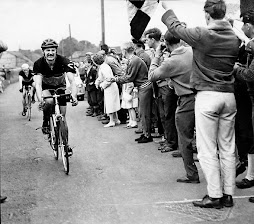One week to go folks! - and courtesy of Barry Davies (see below) the first of a batch of historic Three Peaks photos. This one amply demonstrates (1) the advances in equipment in the last 3 decades (2) how tough the 'Peaks course can be on hardware and possibly (3) the need for proper preparation...
This is George Mason from Wakefield-based club Calder Clarion. Taken just outside the famed Pen-y-Ghent Cafe in Horton-in-Ribblesdale High Street. George has clearly bust his wheel on the super-rocky final leg of the descent of Pen-y-Ghent. The exit from the lane off the peak is hidden in the trees in the left background, and given that in those days the start & finish was at the Sports Pavilion at the north end of the village - he has the best part of a mile left to get home on foot... (addendum 1: Barry Davies has just contacted me to say that he believes that the finish was situated outside the Pen-y-Ghent Cafe until 1975 - so this is a pic of George crossing the finish line and probably explains his relatively cheery visage...)
Failures of this type are rarely seen these days. The worst my 14 stone bulk has ever been able to inflict on a wheel is a small ding in a MA2 rim (but no puncture though - and I only discovered the damage at the finish). Nevertheless Pen-y-Ghent remains a bike wrecker if only because the descent is so fast and rocky.
Best advice would be to use good equipment and not to sacrifice strength for weight. Never use anything new and untried and make sure you are carrying at least a spare tube, repair outfit and tyre levers. Ideally a multitool too - and I always have a CO2 pump; rather than one of those joke MTB minipumps that inflate to about 10psi on a good day...
Barry is unsure exactly when this pic was taken - but the Mk1 Cortina at the side of the road indicates that it's probably late '60s - early '70s and shows a typical 'Cross bike of the time, very few riders at the time had access to specialised 'Cross equipment (in fact most of the stuff we use now hadn't been invented!)
So note the Woodrup touring / training frame with big clearances and clamp-on (?!) cantilever brakes and GB levers. Sprints - probably Fiamme; and tubs (sew-ups) with very little knobbly tread - these are likely training tubs with a heavy file tread at best. There's a single Simplex or Campagnolo bar-end gear change lever, Fiamme (or possibly a Milremo or GB clone) nutted stem and finally the ubiquitous 'bivvi-bag' strapped under a drilled plastic saddle. (addendum 2: A rather closer look at the photo reveals that the frame has actually got brazed-on canti' bosses - and so effectively represents the 'state of the art' for 'Cross kit in those days).
Not seen in this image is the drive train. This is probably a single 40 or 42 tooth ring with home-made ring-guards on either side and a wide ratio 5-speed block at the back - plus steel platform touring pedals with double clips and straps.
George seems to be wearing a pair of leather winter cycling boots which have almost certainly had football (soccer) studs nailed into the heels. Other popular footwear for 'cross at that time were football boots with the front studs cut off and cross country shoes with heavily ribbed soles.
Note also that there's not an inch of lycra or advertising in sight. Wool or viscose club jersey, wool shorts and a long-sleeve shirt underneath.
Unless you were licenced professional rider, to attempt to wear a trade jersey or shorts in those halcyon days might have been an invitation to be officially declared a 'professional' sine die - not a practical option for most club men then*. Hence the poliferation of black duct-tape on shorts and jerseys in some pictures of the time.
*However it must be said that 'Cross in the UK was then run by the BCCA (British Cyclo Cross Association) and not the BCF. Let's just say that the BCCA had a rather more 'pastoral' view on these matters than did the BCF...






No comments:
Post a Comment